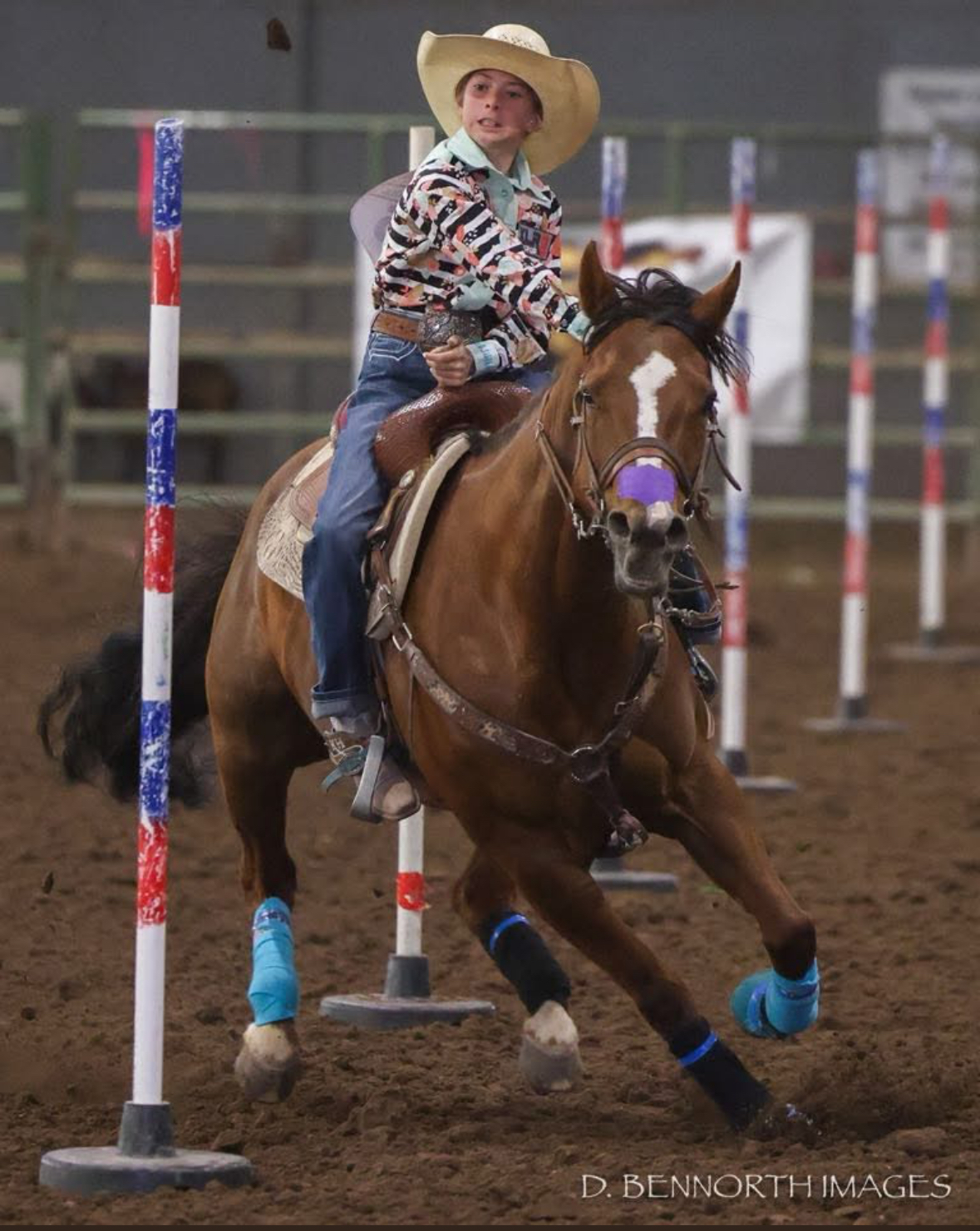The Breath of Champions: Optimizing Respiratory Health in Rodeo Speed Horses – Part 1
Posted by FLAIR Strips on Jun 27th 2025
Rodeo speed horses—whether barrel racing, pole bending, or timed events—are among the most finely tuned athletes, combining explosive power, agility, and stamina, yet one critical aspect of their performance often goes overlooked: their respiratory system. Understanding how these horses breathe, how their lungs support high-intensity exertion, and the respiratory challenges they face is key to optimizing performance, training and long-term health and success. In these high-speed events, the ability to breathe efficiently is a game-changer, making the difference between victory and defeat.
The Respiratory Demands of Speed Events
Speed events demand explosive acceleration and rapid transitions, where every fraction of a second matters. These intense bursts push a horse’s respiratory system to the limit, as horses rely solely on their nostrils for airflow. As oxygen demand skyrockets during high-speed efforts, horses generate strong negative pressure in their chest to pull air through the nasal passages, larynx, and trachea. The strong negative pressure raises the risk of airway collapse, especially in the nasal passages. It should be noted that more than 80% of total breathing resistance comes from the upper airway and 50% of the upper airway resistance is due to resistance in the nasal passages, particularly the nasal valve
The workload of breathing increases exponentially with higher intensity and duration of effort. When racing at full speed, horses may take 120 to 140 breaths per minute. That’s roughly one breath every half second, moving as much as 1,800 liters or 6 bathtubs of air, per minute. The speed and volume of airflow generate massive turbulence and resistance, leaving little time for efficient oxygen exchange.
The fast but short-lived energy-generating anaerobic nature of these events (about 70% powered by glucose and glycogen) leads to high lactic acid production and rapid fatigue, while the smaller aerobic component (about 30%) relies on more efficient energy generation from fat but requires optimal oxygen intake via efficient breathing to delay fatigue and maintain efficiency.
Respiratory Challenges in Speed Horses: A Delicate Balance of Power and Breath
Rodeo horses perform at the intersection of power, agility, and extreme respiratory demand. Each maneuver—whether exploding at the start, launching from the roping box, rounding a barrel, accelerating out of turns, or facing up to a steer—places significant stress on the respiratory system. During explosive efforts, horses momentarily close their windpipe and often hold their breath to stabilize their core. To recover, horses instinctively take deeper, more controlled breaths in brief straightaways or after turns, but syncing these recovery breaths with the rhythm of a run is challenging.
Acceleration at the start of a run, between obstacles, catching a steer or accelerating by, or during a final burst to the line rapidly peaks heart and respiratory rates in seconds. These efforts create vacuum-like negative pressure in the airways and extremely high blood pressure in the lungs. Fatigue compounds this issue, further increasing airway resistance and reducing oxygen efficiency.
Events like barrel racing and pole bending demand explosive hindquarter power, balance, agility, and precise footwork. Horses must find fleeting opportunities—sometimes within three strides around a turn—to take meaningful breaths that support continued muscle performance.
Precise lateral movements, weaving, and split-second directional changes also require advanced coordination, stamina, and finely tuned locomotor-respiratory coupling (LRC). When breathing becomes labored, horses may struggle to maintain stride timing, leading to errors in positioning or pace.
Roping and steer events add further complexity. Heading horses decelerate rapidly, turn sharply, control, tow, and brace forcefully to face the steer. Calf horses sprint, dodge, reverse, and hold tension—often folding back on themselves under load. Heeling horses match every stride of the steer, adjust for a clean shot, and time their stop precisely to absorb rope tension. Each of these actions interrupts breathing, causes momentary breath holding, and creates sudden pressure shifts in the chest.
The repeated patterns of stop-start motion, directional change, and sudden load create massive oxygen demands while generating powerful negative thoracic pressures, and sharp resistance impacts airway stability and airflow. For speed horses to perform at their peak, they must synchronize breath with stride movement, maintain stamina through efficient oxygen delivery, and transition cleanly between phases without compromising airflow. Even the smallest disruption in breathing rhythm can be the difference between winning and losing.
Optimizing Airflow: The High-Stakes Balance Between Breathing and Performance

To meet the intense demands of rodeo events, horses rely on several adaptive mechanisms to optimize airflow and reduce resistance. These include dilation of the external nares, full laryngeal abduction, and bronchodilation—all of which serve to maximize airway diameter and promote smoother, more efficient breathing. Additionally, a horse’s stride length and frequency are closely tied to its breathing efficiency; longer, more fluid strides allow for deeper breaths, reducing the energy cost per breath and enhancing oxygen exchange.
The mechanics of breathing are also deeply integrated with movement. The horse’s chest functions much like a syringe: the ribcage acts as the barrel, while the diaphragm operates as the plunger, aided by the motion of the limbs. This synergy between movement and ventilation helps conserve energy and promote airflow. However, under intense exertion, even these adaptations reach their limits.
As exercise intensity nears its peak, so does the demand for oxygen and the volume of air required to meet that need. The physical challenge of moving a massive column of air at increased frequency—known as inertance and impedance—creates substantial resistance in the airways. To overcome this, the diaphragm and respiratory muscles must work significantly harder, leading to a dramatic rise in the energy cost of breathing.
At extreme effort, breathing can consume 15–20% of the available oxygen-rich blood—oxygen that would otherwise be directed to the skeletal muscles. This diversion compromises muscular performance, accelerating fatigue, reducing stride efficiency, and diminishing both speed and power output. When the metabolic cost of ventilation exceeds the energy available for muscle contraction, performance inevitably declines.
This delicate balance underscores the critical importance of optimal respiratory function in high-level equine athletes. When breathing becomes too costly, it can spell the difference between a winning performance and a missed opportunity—making efficient airflow not just beneficial, but essential.
Managing Respiratory Strain Between Runs
If a horse's breathing is compromised, fatigue sets in faster, negatively impacting subsequent runs and increasing the risk of chronic respiratory conditions. For horses competing in multiple rounds over a single day or weekend, recovery is just as important as performance.
Optimal respiratory function and efficient recovery between runs minimizes the effects of cumulative strain on the respiratory system, is essential for hitting peak performance in subsequent runs, and reduces the risk of exercise-induced pulmonary hemorrhage (EIPH).
Mechanical Factors: Tack, Positioning, and Their Respiratory Consequences
Mechanical factors like poorly fitted tack or restrictive positioning can compromise breathing efficiency. Tight girths, mal-fitting bits, nosebands, or excessive rein pressure can increase airway resistance, destabilize the upper airway, disrupt stride frequency and rhythm, and force the horse to work harder for each breath.
Head and neck position are also important. While extension of the head and neck helps keep airways open, performance demand often require flexion. Flexing the head and neck can narrow the upper airways, reduce stride efficiency, increase airway resistance and compromise airflow.
Conclusion
Rodeo speed horses are among the most finely tuned athletes in the world. Keeping them at peak performance requires constant consideration of all body systems. The respiratory system is particularly critical to the performance of these elite athletes. In future blogs we will discuss infectious, inflammatory and functional conditions of the respiratory system that can negatively impact performance. But, even in horses having normal respiratory system function, intensive exercise can compromise airflow. And the situation can be made even worst by improper tack fit and head/neck positioning that impact free breathing that is required to supply the oxygen needed to fuel performance.






